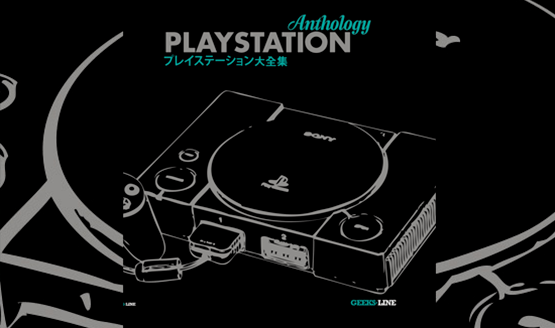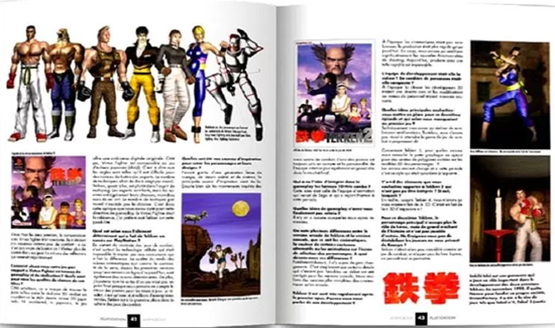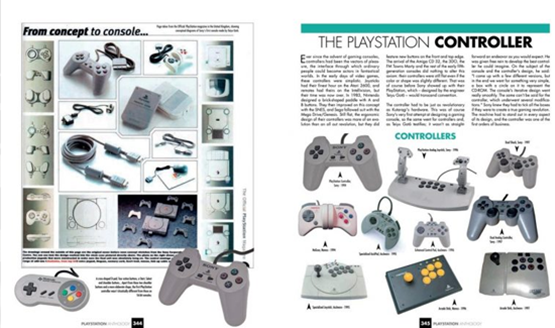My gaming didn’t start with PlayStation, but I do consider the 1995 release of the original PlayStation console to be a major turning point in my world. I had friends with old Nintendos and I played a myriad of cheap computer games I’d pick up at the dollar store on floppy disks. I spent hours upon hours on Myst’s strange island, one of my first CD-ROM games. Then, in 1995, Sony changed the gaming world.
The PlayStation Anthology book actually starts 50 years before the release of that first PlayStation console, with the creation of Sony in 1945. I didn’t expect to start out reading a book about PlayStation only to find myself entrenched in the history of post-WWII Japan, but it’s details like these that make PlayStation Anthology such a special read. Everything in its 380+ pages delves into the kind of details that I didn’t even know I wanted, but I am more than happy to have.
The History of PlayStation
The first third of the PlayStation Anthology book covers the history of the console, from the inception of Sony to the end of production in 2006. As this does overlap with the release of the PS2 and PlayStation Portable, the book covers how the PlayStation’s success springboarded Sony forward as a company. It doesn’t simply end with the release of the PS2, as the original grey console continued to make a massive impact on gaming. Writing the history in this way also makes this a great standalone volume that doesn’t feel like it has a hard cutoff. If the writers do decide to publish another book that goes into the PlayStation 2 era, however, they have a great overlap point to make the books feel cohesive.
Geeks-Line, the publisher behind PlayStation Anthology, originally wrote and published a Nintendo 64 Anthology. That book is being followed by a GameCube Anthology coming Summer 2018, so it’s easy to expect that a PlayStation 2 Anthology might follow to continue to tell the story of Sony’s consoles.
The most important part of this opening section is the context it provides. It’s full of interesting details and facts that you aren’t going to find collected anywhere else. It shows the different iterations of the logo before landing on the iconic one we know today. The book talks about Sony trusting publishers and developers and how that allowed the company to win them over despite inexperience with games. It’s actually not until page 34 that we get to the release of the PlayStation, the previous 33 pages setting the stage for that moment. Mascots, both successful and failed, are looked at. There are even comparisons drawn to other consoles and popular properties of the time, such as the Dreamcast and Pokemon.
The middle portion goes into interviews with 26 figures pivotal to PlayStation’s success. Naughty Dog’s Jason Rubin, Final Fantasy Director Yoshinori Kitase, and Ian Livingstone, founder of Eidos Interactive are just a few of the notable faces that grace PlayStation’s epic yearbook. The in-depth interviews explore much of the unique history at a critical turning point for video games. They each give their reactions to the gaming scene, how they got into it, and what their thoughts were about the technology and working with Sony. Their own histories in gaming are explored, before talking about numerous interesting details behind the games they each were a part of.
Next, the PlayStation Anthology shows off collectibles and special editions of various games. This section was easily the least interesting to me, but collector’s will be fascinated by the cataloging of old special edition packages for various PlayStation titles, including Metal Gear Solid, Crash Team Racing, and many more.
Finally, we get into the hardware specs, evolution of the PlayStation controller, and creation of hardware accessories like the PocketStation. One aside talks about the black-bottomed discs that PlayStation was famous for (simply a design choice to stand out from other CDs and DVDs of the time). Creation of the original PlayStation controller is a particularly fascinating read. Up until the PlayStation’s release, the world didn’t have ergonomic gaming controllers that sat nicely in your hands. They were generally flat gamepads, which is actually why that term was coined. If you’ve ever wondered about the story behind triangle, circle, cross, and square as the PlayStation buttons, the PlayStation Anthology covers that fascinating bit of history too. As a bonus, the end of the book provides some insight into PlayStation games that never saw the light of day.
A Graphic Design Dream
From a design standpoint, this is a book to display. As rewarding as it is to sit down and read it cover to cover, the large size, glossy pages, and superb graphic design just call for it to be thumbed through casually. I’ve got mine sitting on my coffee table, a proud mark of my own history as a PlayStation gamer. PlayStation Anthology is a great mixture of text and images laid out in a very eye-pleasing fashion, which creates that balance for the dedicated readers and those who just want to glance inside the cover.
I have one small issue with some of the pictures and images being extremely pixelated, and not just because they are old game screenshots. The efforts the writers must have gone to in order to cultivate some of these old PlayStation ad campaign posters, hardware, and game pictures must have been staggering for a time when everything wasn’t readily archived on the internet. A few pixelated images are minor quibbles that are quite forgivable when the rest of the quality is outstanding.
The book was originally written in French and translated for English audiences. It seems like France has a lot of great in-depth video game history writers that are passionate about their work. Third Editions, another French publisher of gaming specialty books, provides a similar but very different product for gaming audiences, focusing instead on full-text books centered around specific games and series.
Due to the translation, there are occasionally some odd hiccups in wording and grammar, but again, the clear passion and quality that went into every other aspect of the PlayStation Anthology makes these issues seem non-existent and sometimes even charming. The writing is passionate and full of detail that you won’t find anywhere else. Each section flows into the next, providing the ability to read it straight through, or in bits and pieces at your leisure. Sidebars, quotes, tables, and diagrams help to further illustrate every point being brought up.
If PlayStation has made any kind of an impact in your life, you owe it to yourself to own the PlayStation Anthology. I’m the type of PlayStation gamer that has a blueprint poster of the original PlayStation and DualShock controller on the wall of my living room. The PlayStation Anthology has taken a proud spot as the centerpiece of my coffee table so that everyone can see. Even though I’ve read the book cover to cover, I still often find myself thumbing through it again and again to reread interesting details and relive the history of PlayStation. There’s a certain magic in writing, and PlayStation Anthology effectively transports readers back to a major turning point in games with a high quality and well produced book.
PlayStation Anthology was provided by FunstockRetro.co.uk for the purposes of this review.











